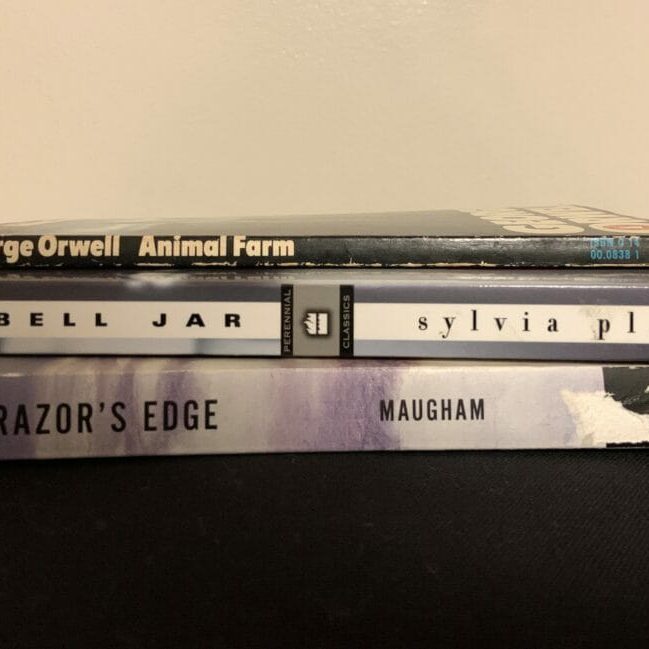
Feeling Our-shelves: With Lili and Reanna
Classic must-reads
In this edition, we recommend four classic novels. Though these have been around a little while, we’ve found they’re still worth the read in 2022.
The Razor’s Edge – W. Somerset Maugham, 1944
The Razor’s Edge is told through the point of view of the author, W. Somerset Maugham. It follows characters Larry Darrell, Elliot Templeton and Isabel Bradley as they navigate life in their own dysfunctional ways. Larry is a World War II veteran, who denounces a typical American existence in order to discover the meaning of life. Elliot Templeton is an aging social climber who values status more than real human connection. Isabel Bradley is a young woman who loves Larry to the point of desperation.
The story takes place in a variety of locations: Chicago, Paris, India and more — the evolving settings each bringing extra interest to the story. Maugham’s observational narrative provides a nuanced understanding of each of the character’s emotions and complexes.
There’s an unidentifiable quality about The Razor’s Edge that makes it an impactful and memorable book. The sometimes slow plotline, but nevertheless captivating writing, is reminiscent of John Steinbeck’s novel East of Eden — one of the top five books I read in 2021.
The Bell Jar – Sylvia Plath, 1963
Sylvia Plath’s The Bell Jar reflects her own struggles with mental health, and her skillful writing makes the reader feel like they’re experiencing the plotline themselves along with the protagonist, Esther Greenwood.
The story starts off rather lighthearted. Esther is a 19-year-old intern at a magazine in New York, learning about life in a big city and transitioning from adolescence into adulthood. When her internship is over, she returns to her hometown near Boston where she falls into a severe depression. After not being able to sleep for days, she attempts to end her life but is resuscitated and admitted to a mental facility where she is treated by Dr. Nolan.
One can tell from Plath’s writing that Esther’s slow progression from sanity into depression is something that she understands all too well, making the story an emotional testimony to the importance of addressing mental health issues and suppressing the stigma that surrounds the subject.
The Handmaid’s Tale – Margaret Atwood , 1985
Margaret Atwood’s The Handmaid’s Tale tells the story of Offred, a handmaid in a dystopian, futuristic version of the United States where infertility is widespread and men are in power. The role of a handmaid is derived from the biblical definition in Genesis, where women are enslaved with their sole value being their uterus and ability to birth children. In The Handmaid’s Tale, Offred is a handmaid for a powerful couple in the new government: the Commander and his wife, Serena.
A particularly terrifying aspect of this story is that Offred, formerly known as June, remembers her past — as it was only a few years before the beginning of the novel — when she was still leading a normal life with a job and family.
The society’s transformation is hauntingly rapid, and the torture June receives is disturbing. All the injustices and pain inflicted on June and the other women in the novel are only partially fictional. Everything has actually taken place to women at some point in history. The Handmaid’s Tale is an impeccable modern classic – a feminist novel everyone should pick up as soon as possible.
Animal Farm – George Orwell, 1945
George Orwell’s Animal Farm tells the tale of farm animals in England overthrowing their terrible owner, Mr. Jones.
The animals rename their farm to Animal Farm, creating their own rules and hoping to create their own perfect farm. Animal Farm seemed like the perfect idea, but when certain individuals manipulate others into a hierarchy, the rest of the animals must decide their fate. George Orwell uses the novel as an allegory for Russian history, drawing parallels to the events of the Russian Revolution, and characters representing historical figures like Vladimir Lenin, Karl Marx, and Joseph Stalin. There are strong ties to the propaganda of the Soviet Union, and Russian labourers are represented by the characters in the story. Though this is widely accepted as specifically referencing the Russian Revolution, the novel’s themes can be applied to any society and the complications that come with all systems of governance.
The majority of the people I’ve spoken to groan and roll their eyes at the mention of Animal Farm, due to the classic being on most high school English reading lists. However, the novel is a great read for its satirical nature, short length, and all-around genius. I read Animal Farm for class in grade eight and I hated it at the time. However, I recently decided to read it again. I’m glad I did, because it is undoubtedly a five-star read.






